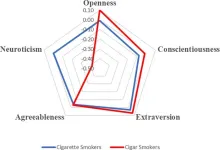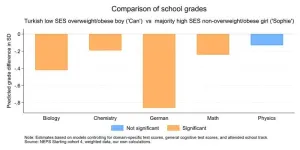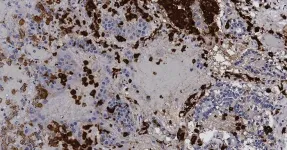(Press-News.org) The cerebellum is a region of the brain that helps us refine our movements and learn new motor skills. Patients and mouse models experience many kinds of abnormal movements when their cerebellum is damaged. They can have uncoordinated and unbalanced movements, called ataxia. They can have atypical positioning of body parts or uncontrolled movements because their muscles are working against each other, called dystonia. Or they can have disruptive shaky movements, called tremors. Understanding how changes in a single brain region can result in such a diverse range of motor defects has been a longstanding question in the field.
A recent study from the laboratory of Dr. Roy V. Sillitoe, a professor at Baylor College of Medicine, and the Chao Family Endowed Chair and a principal investigator at the Jan and Dan Duncan Neurological Research Institute (Duncan NRI) at Texas Children’s Hospital, found that the way cerebellar neurons communicate with other brain regions is different in various movement disorders. The team found unique cerebellar activity patterns responsible for different abnormal movements. This work provides a foundational framework for new treatment approaches to movement disorders. The study was published in eLife.
“Brain cells communicate with each other through neural signals,” co-first and co-corresponding author of the study, Dr. Meike van der Heijden said. “Those signals occur in specific patterns that represent a code for specific behaviors. Studying the code produced in the cerebellum gives us information about the animal’s movements. We wondered whether we could crack the code for different movement disorders by comparing cerebellar neural activity patterns in healthy versus mice with ataxia, dystonia, and tremors. To address this question, we built a computational model and revealed that cerebellar neurons fired differently in healthy compared to animals with disease-specific behaviors. Moreover, cerebellar neurons in each of the disease mouse models showed a distinct and unique neural code."
“We performed further studies with other disease models to test whether different genetic or drug-induced origins of abnormal movements influenced the disease code. Importantly, we found that – irrespective of the disease origin – the abnormal features of the neural signals in mice with similar movement disorders were the same. However, those activity patterns were distinct in mice with different conditions,” co-first author of the paper and postdoctoral fellow in the Sillitoe lab, Dr. Amanda Brown, said. “This gave us the first hint that these unique neural codes may not just correlate with different abnormal movements but also cause them.”
The researchers next mimicked the effects of these neural codes in healthy mice using optogenetics, an elegant approach that combines optical and genetic engineering techniques for precise regulation of biological functions in target cells. This technique allowed the researchers to shine a light on the cells in flashing patterns to alter the cells’ activity pattern. They found that when they changed the light pattern, they could reliably switch the neural signal patterns of cerebellar neurons from a healthy code to the desired disease code.
The team then used these different light patterns to change the cerebellar neural code of healthy mice to test if they could create disease behaviors on demand as the mice freely moved around in a box. “When we induced the activity patterns associated with ataxia, our healthy mice immediately exhibited ataxic movements. The same mice displayed dystonic movements with the dystonia-associated pattern and developed tremor when they were given the tremor-associated pattern.” Dr. Brown added. “This means that each disease-associated neural pattern is alone sufficient to cause distinct dysfunctional behaviors, even in healthy brains.”
“Together, our findings provide strong evidence for the important role of unique activity patterns of cerebellar neurons in generating different movement disorders.” Dr. Sillitoe said. “Movements in the cerebellum of healthy animals are likely regulated by a range of activity patterns, and movement disorders occur when neurons shift within the range to a neural code that promotes one of the dysfunctional movements. Our study highlights the importance of studying cerebellar neural signals in health and disease. It points towards a potential new strategy of treating movement disorders by finely regulating the activity of cerebellar neurons.”
----------------------------------------------------------------------------------------------------------------------------
All authors associated with the study and their institutional affiliations can be found here. The study was supported by Baylor College of Medicine, the Jan and Dan Duncan Neurological Research Institute, Texas Children’s Hospital, Hamill Foundation, Dystonia Medical Research Foundation, the National Institutes of Neurological Disorders and Stroke (NINDS) R01NS100874, R01NS119301, and R01NS127435, by the Eunice Kennedy Shriver National Institute of Child Health & Human Development of the National Institutes of Health under Award Number P50HD103555 for use of the Cell and Tissue Pathogenesis Core and In Situ Hybridization Core (the BCM IDDRC). They were also supported in part by K99NS130463, F31NS101891, and by start-up funds provided by the Red Gates Foundation and Virginia Polytechnic Institute and State University.
END
Cracking the code for cerebellar movement disorders
2024-07-03
ELSE PRESS RELEASES FROM THIS DATE:
Stability indicating RP-HPLC method for the estimation of impurities in esomeprazole gastro-resistant tablets by AQbD approach
2024-07-03
https://www.scienceopen.com/hosted-document?doi=10.15212/bioi-2024-0018
Announcing a new article publication for BIO Integration journal. Esomeprazole (ESO) gastro-resistant tablets (40 mg) are sold under the brand name, Zosa, which effectively manages conditions associated with the overproduction of gastric acid, including peptic ulcer disease and Zollinger-Ellison syndrome. This article quantifies impurities in esomeprazole using advanced analytical techniques known as analytical quality by design with high-performance liquid chromatography.
Buffer selection ...
Clinical implications and procedural complications in patients with patent foramen ovale concomitant with atrial septal aneurysm
2024-07-03
https://www.scienceopen.com/hosted-document?doi=10.15212/CVIA.2024.0038
Announcing a new article publication for Cardiovascular Innovations and Applications journal. Atrial septal aneurysm (ASA) is defined as excursion of the atrial septum exceeding 10 mm beyond the atrial septum into the right or left atrium, or a combined total excursion of 15 mm on the right and left sides during the cardiac cycle. According to previous studies, 20–40% of patent foramen ovale (PFO) cases are accompanied by ASAs. ASA is associated with the presence of PFO, left atrial dysfunction, cryptogenic stroke, migraine, and arterial embolism, thus making ...
Cryptocurrency investors are more likely to self-report “Dark Tetrad” personality traits alongside other characteristics
2024-07-03
Owning cryptocurrency may be associated with certain personality and demographic characteristics as well as a reliance on alternative or fringe social media sources, according to a study published July 3, 2024 in the open-access journal PLOS ONE by Shane Littrell from the University of Toronto, Canada, along with colleagues from the University of Miami, USA.
Anonymous trading and unregulated markets hallmark cryptocurrency’s unique subculture. While some consider the digital currency to be financially unreliable, hundreds of millions of global investors think otherwise.
This study identified various political, psychological, and social characteristics ...
Smoking behavior is linked to personality traits
2024-07-03
Cigarette smokers, cigar smokers, and non-smokers each have distinct personality profiles, according to a study published July 3, 2024 in the open-access journal PLOS ONE by Dritjon Gruda from Universidade Catolica Portuguesa, Portugal, and Jim McCleskey from Western Governors University, USA.
Tobacco use remains a formidable global public health challenge, responsible for more than 8 million deaths annually, including those attributed to second-hand smoke exposure. Emerging research underscores the critical role of psychological factors, including personality traits, in shaping ...
Minority status, social origin, gender, and weight can all count against a German kid’s grades
2024-07-03
A new study done in more than 14,000 ninth graders in Germany has revealed that students experience grading bias based on their gender, body size, ethnicity and parental socio-economic status. These negative biases stack on each other, meaning that students with multiple intersectional identities get significantly lower grades than their peers regardless of their true abilities. Richard Nennstiel and Sandra Gilgen of the University of Bern and University of Zurich in Switzerland present these findings in the open-access journal PLOS ONE on July 3, ...
Dengue linked to heightened short- and long-term risk of depression in Taiwan
2024-07-03
Analysis of the medical records of nearly 50,000 people who experienced dengue fever in Taiwan suggests that this disease is associated with elevated short- and long-term risk of depression. Hsin-I Shih and colleagues of National Cheng Kung University and National Health Research Institutes, Taiwan present these findings in the open-access journal PLOS Neglected Tropical Diseases.
People may develop dengue fever after being bitten by a mosquito carrying the dengue virus. Dengue fever can be mild, but it can also progress ...
Fighting COVID-19 with a cancer drug
2024-07-03
Twelve years ago, cancer researchers at University of California San Diego identified a molecule that helps cancer cells survive by shuttling damaging inflammatory cells into tumor tissue. In new research, they show that the same molecule does the same thing in lung tissue infected with COVID-19 — and that the molecule can be suppressed with a repurposed cancer drug. The work, published in Science Translational Medicine, represents a new approach to preventing irreversible organ damage in infectious diseases like COVID-19 and methicillin-resistant Staphylococcus aureus (MRSA).
The two key players in this scenario are inflammatory cells called myeloid ...
From ‘hit to vial’: Discovery and optimization of a promising vaccine adjuvant
2024-07-03
Many vaccines are only partially effective, have waning efficacy, or do not work well in the very young or the very old. For more than a decade, Ofer Levy, MD, PhD, and David Dowling, PhD, in the Precision Vaccines Program at Boston Children’s Hospital, have tried improving vaccines by adding compounds known as adjuvants to boost vaccine recipients’ immune responses.
Now, under a large Adjuvant Discovery Program contract from the National Institute of Allergy and Infectious Diseases ...
Why do you keep your house so cold? Science says: Ask your parents
2024-07-03
Childhood home temperature and community connectedness can help predict how U.S. residents set their thermostats, offering new ways to encourage energy conservation and combat climate change, according to a study published July 3 in the open-access journal PLOS Climate by Dritjon Gruda from the National University of Ireland Maynooth and Paul Hanges from the University of Maryland.
Half of U.S. households’ annual electricity use goes to heating and cooling, but less than half of homeowners tweak their thermostats to save energy ...
Texas A&M center receives $7.6 million grant to promote research in environmental health
2024-07-03
The Texas A&M Center for Environmental Health (TiCER), a National Institute of Environmental Health Sciences (NIEHS) Environmental Health Sciences Core Center, will be returning to the Texas A&M School of Veterinary Medicine and Biomedical Sciences (VMBS) with a $7.6 million grant for the center’s new funding cycle.
Under the new leadership of Dr. Weston Porter, a VMBS professor in the Department of Veterinary Physiology and Pharmacology, the center will promote research in four areas of environmental health — climate ...




